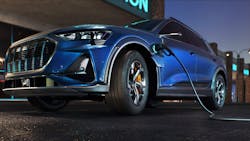Many electric vehicle (EV) owners expect a quiet ride. Tires engineered and built for EVs contain a variety of technologies, including components designed to minimize noise. Tire manufacturers discuss sound deadening technology more in this MTD exclusive.
MTD: Why do you build sound-dampening materials into your EV-specific tires?
Brad Robinson, senior product manager, Bridgestone Americas Inc.: With EVs, tires account for upwards of 30% of cabin noise in the absence of internal combustion engine (ICE) noise, which makes tires a bigger factor in the overall customer experience. EVs are heavier and tend to have stiffer suspensions, which can impact how resonant sounds from the road and tire are transmitted to the cabin. These factors were incorporated into the Turanza EV, when determining the design and technology features we wanted to include.
Dave Reese, vice president of product development, North America, Goodyear Tire & Rubber Co.: As consumers adopt more EV technology and adapt to the new powertrain, we’re all discovering the differences between EVs and ICE vehicles. Both produce noise as they move around, but EV noise is different and, in the absence of traditional engine noise, some road noise can be more noticeable when considering the quiet ride we expect with EVs. My team’s challenge at Goodyear is to find ways to lessen the noise and find a balance between the road, the tire and the EV powertrain.
Moonki Cho, product manager, Hankook Tire America Corp.: In an ICE vehicle, powertrain noise accounts for 50% of the noise heard in total and road noise emitted by the moving vehicle takes up 30%. In an EV, on the other hand, electric motor noise accounts for 15%, road noise for 40% and wind noise from high-speed driving for 30%. This places newfound importance on the tire’s ability to combat road-going feedback or “tire droning,” which becomes even more pronounced at highway speeds. Excessive road noise can be a distracting and fatiguing element for drivers and passengers.
Walter Chen, product planning specialist, Maxxis International-USA: The integration of sound-dampening materials and design into EV-specific tires serves the crucial purpose of reducing tire noise. This reduction in tire noise becomes more noticeable in electric vehicles due to the absence of engines, transmission and exhaust noise. It is particularly prominent in base EV models that may not have effective sound-deadening materials installed.
Russell Shepherd, technical communications director, Michelin North America Inc.: First, not all EVs require sound dampening material in their tires. More and more vehicle manufacturers are offering EVs with original equipment tires that are without acoustic materials. Examples include Cadillac, Chevrolet, Porsche and Hyundai. For original equipment manufacturers and consumers who are interested in sound-dampening materials, it’s primarily used to reduce cavity noise.
Steve Bourassa, director of products, North America, Nokian Tyres Inc.: Low rolling noise is a top priority of EV drivers, since electric vehicles make virtually zero noise apart from tire volume and wind resistance. Noise reduction consistently ranks alongside safety and low rolling resistance as EV drivers’ self-stated biggest needs from their tires. Noise becomes even more noticeable when silent EV winter tires transition from snow-covered roads to asphalt surfaces. It makes sense to help drivers find a solution that delivers a more comfortable ride, without sacrificing safety or range.
Ian Coke, chief technical officer, Pirelli Tire North America Inc.: We do all of this to break up the cavity noise. We try to keep the cavity noise around 190- to 230-hertz for the United States passenger vehicles. Nowadays, tires have gotten bigger and squarer, so we are really playing into the hands of that cavity noise, especially because the EV does not have any type of engine noise to cover tire noise. The importance of covering the noise that comes from the tire — cavity, as well as air-born and structure-born noises — becomes more important.
Wayne Cuculuzzi, vice president of products and product development, Sailun Tire Americas: We didn’t have the need to add sound-dampening materials. With some of the extra considerations you must take in when adding dampening material, we chose not to add, but the reason EVs are more sound-conscious is there is no engine noise to help mask the sound of road noise.
MTD: What sound-deadening materials/components do you build into your EV tires and can you describe how that technology works?
Robinson (Bridgestone): We applied our proprietary QuietTrack technology to the Turanza EV, which mitigates noise from the tire. The main feature are the Quiet Tracks themselves, which are in-groove tracks to help prevent high-frequency noise by breaking up the resonant frequency. We also apply non-chamfered slots on shoulder ribs and an optimized three-pitch sequence in the tread block to mitigate pattern noise.
Reese (Goodyear): Goodyear has many years (of) experience equipping tires within (the) commercial, consumer and off-highway segments with technology to minimize road noise, including a combination of tread design and tire construction. Our EV-specific consumer tires, the ElectricDrive and the ElectricDrive GT, feature Goodyear SoundComfort Technology to reduce road noise. Tires with SoundComfort are designed with a built-in sound barrier that acts like an internal sound-deadening cushion. Our technology applies an open-cell polyurethane foam element to the inner surface of the tire, reducing vehicle interior noise. This acoustical barrier reduces air vibrations and dampens the interior noise in your car while driving.
Choi (Hankook): Across our iON family of products, we have placed a considerable emphasis on implementing the latest noise-proof technology to accommodate EVs’ absent engine noise and heightened road-going feedback. This includes applying knurling technology inside the grooves, which effectively reduces tread pattern noise during road contact by narrowing the atmospheric air path. This extends to our optimized multi-pitch sequencing at the tread surface, in which sound can be reduced further by varying the size and number of pitches. Finally, by applying a noise-absorbing foam material inside the tire’s carcass, cavity noise can be reduced by up to nine decibels.
Chen (Maxxis): In our Maxxis Victra Sport EV tires, we incorporate Maxxis Silent Technology to effectively reduce tire cavity resonance and minimize overall tire noise. This technology involves the application of a layer of sound-absorbing foam to the inner liner of the tire. The foam is specifically designed to absorb and dampen tire cavity noise, resulting in a quieter and more comfortable ride. Furthermore, the closed shoulder tread pattern design of our Maxxis Victra Sport EV tires helps isolate and minimize tire pattern noise caused by contact with the road surface. This design feature further enhances a quiet and enjoyable driving experience for EV owners.
Shepherd (Michelin): Michelin Acoustic Technology (MAT) significantly reduces interior noise, effectively reducing vibrations caused by the road resulting in a significant reduction of interior noise. A custom-designed polyurethane foam solution muffles noise resonance, which allows the drivers and passengers to benefit fully from hands-free communication devices while lessening driver fatigue on long drives. MAT even dampens interior noise when driving on changing road conditions.
Bourassa (Nokian): We employ acoustic foam in the inner liner of a tire to help stifle cabin noise in the tire’s air cavity at the frequencies that are most irritating to drivers. We call it SilentDrive Technology. We use it in our EV-specific winter tires, the Nokian Hakkapeliitta 10 EV (studded) and R5 EV (non-studded). Studded tires are particularly known for being noisy and the acoustic foam helps absorb the vibration caused by (the) studs’ contact with the road. The foam can deaden that noise by as much as nine-decibels, depending on the height of the sidewall and size of the tire.
Coke (Pirelli): We call our noise canceling technology the Pirelli Noise Cancellation System (PNCS). A polyurethane foam structure is used in the PNCS, which is applied to the inside of the tire, stuck to the liner. There are a couple of different dimensions, depending on the size of the tire and its circumference, but we use either an automatic ring that goes all the way around the tire — with a few spots of spaces between the foam — or we use a multi-piece structure. So if you look at the tire and split it at the rim, you can either see two pieces of foam (the automatic ring) with a gap of 50 millimeters between the two pieces, or you’ll see a multi-piece ring, which is made up of about seven pieces of foam.
Cuculuzzi (Sailun): The ERANGE EV tire was designed with sound in mind. We were able to optimize the sound by designing the tread design and rubber compound to keep the sound minimal. The sound aspects of (the) ERANGE EV are based on a tread design and rubber compound optimized for low noise. ERANGE EV tires use proven SilentTread technology and a variable pitch sequence for a quiet, comfortable and safe ride, backed by proven lab and road testing, to meet the highest of standards.
MTD: Can EV-specific tires be repaired in the event of a standard nail-hole injury in the tread area, despite the fact they contain sound-dampening components?
Robinson (Bridgestone): We’re proud of the fact that Turanza EV is quiet and comfortable enough to not require technologies that could impact repairability. It can be repaired as long as it’s safe to do so.
Reese (Goodyear): The short answer is, yes. Our EV-specific tires can be repaired with a standard nail-hole injury, just as you would with any other tire. The built-in, open-cell polyurethane foam element that acts as the sound barrier won’t be impacted by a normal puncture.
Cho (Hankook): Repairing EV-specific tires in the event of a standard nail-hole puncture in the tread areas is generally possible, but it depends on many factors, including the size, location and angle of the puncture. If a repair on the EV tire is advisable, it is important that the process adheres to the Tire Industry Association’s guidelines for proper tire repair.
Chen (Maxxis): Despite the presence of sound-dampening foam in our EV-specific tires, they can still be repaired in the event of a standard nail-hole injury in the tread area. The repair process involves cutting and removing a section of foam, repairing the tire using industry-standard procedures and then re-adhering the foam back into the tire. We recommend having the tire rebalanced before reinstalling it back on the vehicle.
Shepherd (Michelin): Michelin Acoustic technology can be repaired from punctures in the tread. In fact, the U.S. Tire Manufacturers Association has repair procedures, like the Tire Information Service Bulletin (TISB) 52 — Noise Reduction Acoustic Foam Tires. Given the relatively small area required for repairs, consumers should see no difference in sound dampening afterward.
Bourassa (Nokian): Yes, the repair process is the same for EV-specific tires. The only difference would be the need to cut the section of foam where the damage occurred, being careful not to damage the inner liner in the process. The small amount of acoustic foam removed will not make a significant difference in sound absorption following the repair.
Coke (Pirelli): Yes, you can repair them. You must carefully remove the sponge because you don’t want to leave foam debris in the hole plug. It takes time to remove the sponge and prepare the liner to put the plug in. But these tires are repairable.
Cuculuzzi (Sailun): Because we do not build in any special physical components, our tire is as fixable as any tire. Others that use sound dampening foam or insulation are much tougher to fix, as the foam/insulation must be removed, tire fixed and then foam/insulation replaced exactly as-is/as-was or you risk ride disturbances.
About the Author
Madison Hartline
Associate Editor
Madison Hartline (Gehring) is the associate editor for Modern Tire Dealer and Motor Age. Since joining MTD after graduating from The Ohio State University in 2022, she has taken on the role of managing the brand’s social media strategy, producing podcast episodes and overseeing eNewsletter content.
Don't miss Hartline's next article. Sign up for MTD's newsletter.

